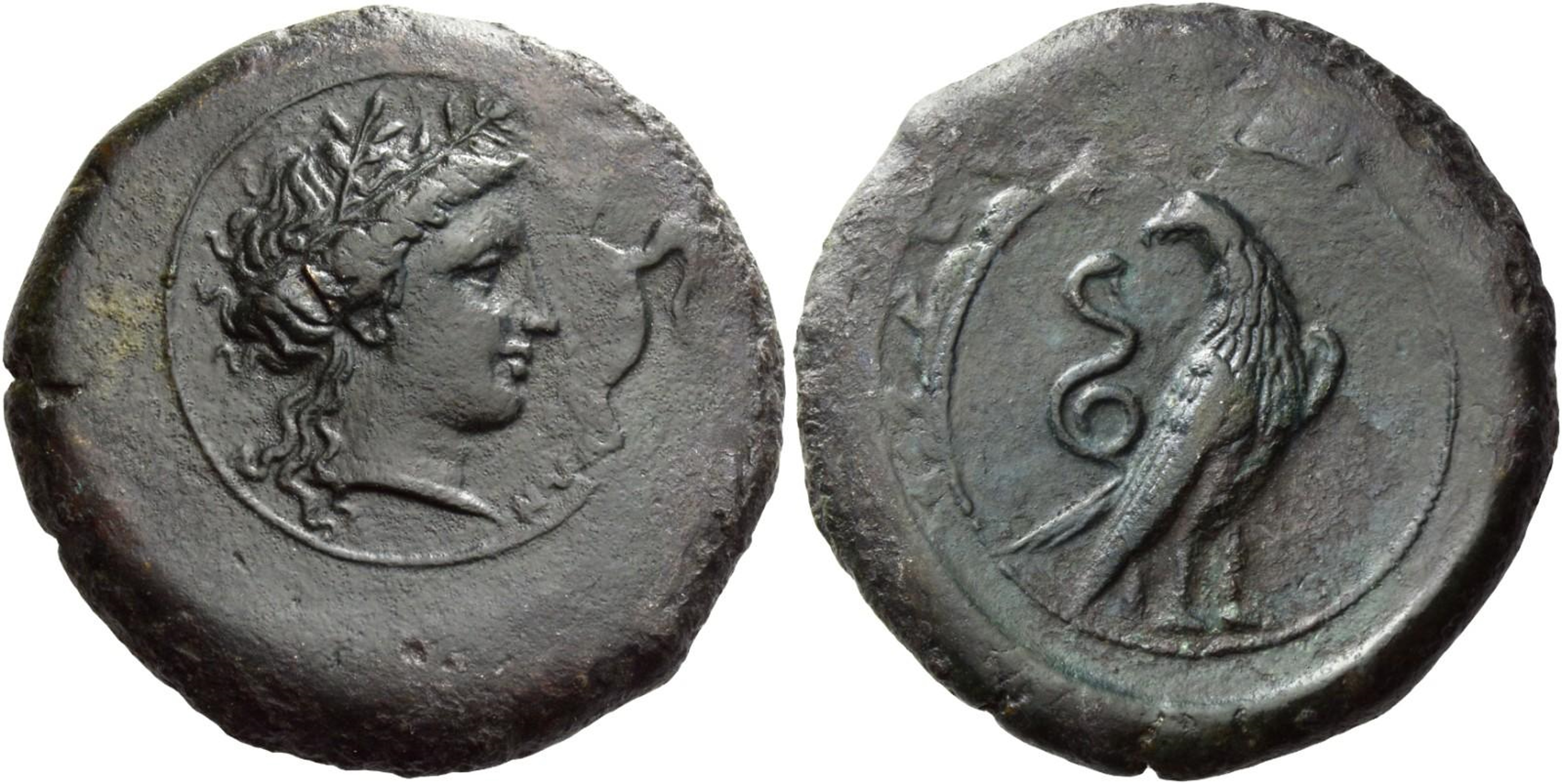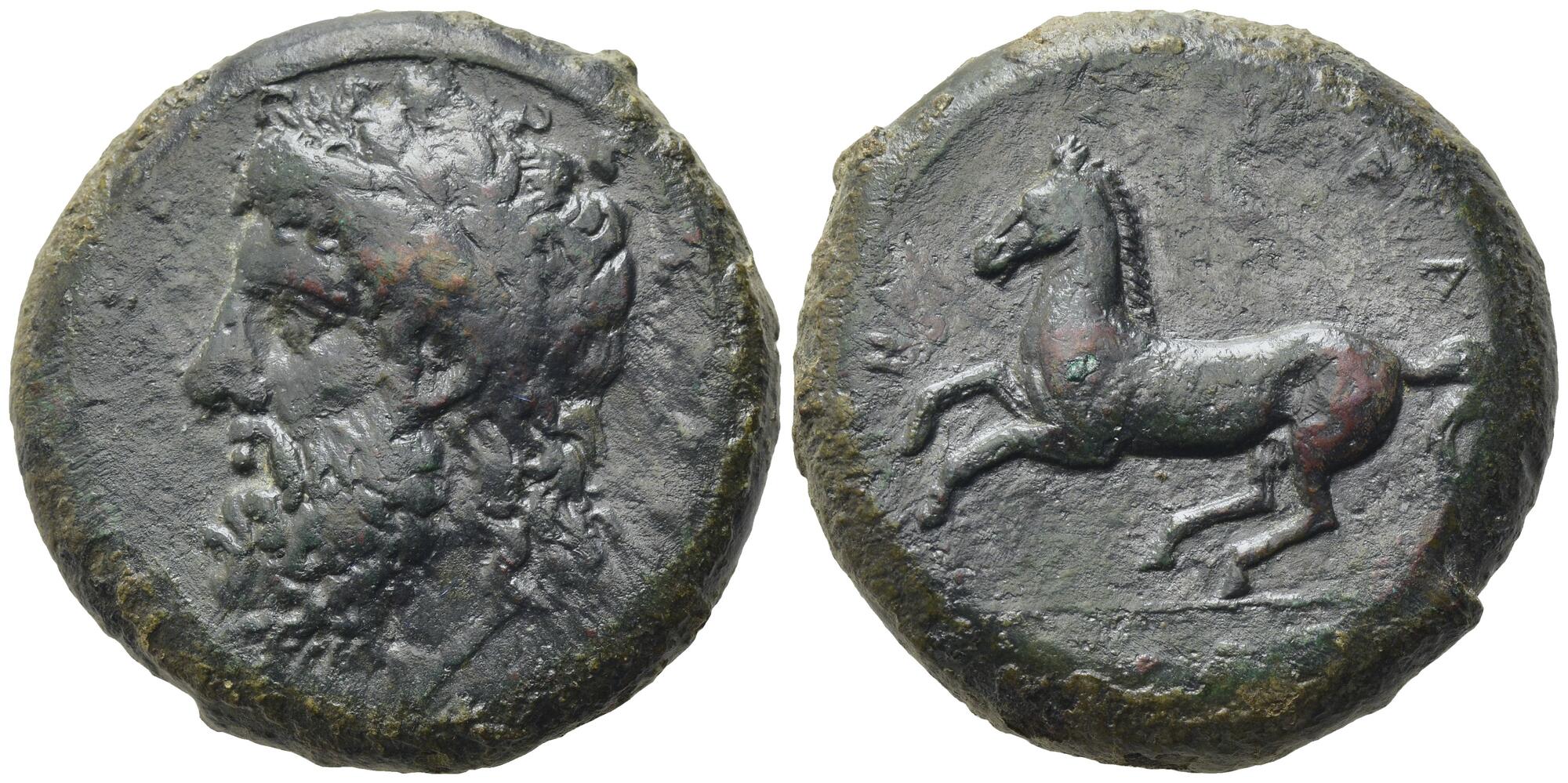335 BCE - 325 BCEΕΡΒΕΣΣΙΝΩΝ
Overstriking coin
SO 1618 - Herbessus over Syracuse (Nomos, 10 May 2011, 15).jpg
[1]
Overstruck variety
SO 2261 - Herbessos over Syracuse (Orville 1764, pl. VIII, 1) overstruck variety.jpg
|
|
Sale(s)Sale(s) ᵖ:
|
Numismatica Ars Classica, 116, 1 Oct. 2019, 41 ; Nomos, 3, 10 May 2011, 15
|
|
|
|
Description
| ObverseInscription or printing placed on the obverse.:
|
ΕΡΒΕΣΣΙΝΩΝ (Greek) Head of Sikelia right, wearing olive-leaves wreath. Linear border.
|
ReverseInscription or printing placed on the reverse.:
|
Snake right and eagle standing right, head reverted. Border of dots.
|
Mint and issuing power
| MintIdentifies the place of manufacture or issue of a numismatic object.:
|
Herbessus
|
Ancient regionAncient region.
|
Sicily
|
Modern countryModern country: Italy
|
AuthorityIdentifies the issuing power. The authority can be "pretended" when the name or the portrait of X is on the coin but he/she was not the issuing power. It can also be "uncertain" when there is no mention of X on the coin but he/she was the issuing power according to the historical sources:
|
|
Chronology
| FromIdentifies the initial date in a range assigned in a numismatic context. 335 BCE toIdentifies the final date in a range assigned in a numismatic context.. 325 BCE
|
Classical 480-323 BC  periodTime period of the numismatic object. periodTime period of the numismatic object.
|
Physical description
MetalThe physical material (usually metal) from which an object is made.: Bronze 
|
WeightWeight of the numismatic object (in grams). in grams: 20.1020.1 g <br />20,100 mg <br />
|
DenominationTerm indicating the value of a numismatic object. Examples: tetradrachm, chalkous, denarius.: dilitron
|
|
|
|
|
References
Description
| ObverseInscription or printing placed on the obverse.:
|
ΖΕΥΣ ΕΛΕΥΘΕΡΙΟΣ (Greek) Head of Zeus Eleutherios left, wearing laurel wreath
|
ReverseInscription or printing placed on the reverse.:
|
ΣΥΡΑΚΟΣΙΩΝ (Greek) Horse galloping left
|
Mint and issuing power
Chronology
| FromIdentifies the initial date in a range assigned in a numismatic context. 339 BCE toIdentifies the final date in a range assigned in a numismatic context.. 334 BCE
|
Classical 480-323 BC  periodTime period of the numismatic object. periodTime period of the numismatic object.
|
Physical description
| DenominationTerm indicating the value of a numismatic object. Examples: tetradrachm, chalkous, denarius. ᵖ:
|
dilitron
|
|
|
References
| Frequency of overstrikesFrequency of overstrikes:
|
frequent
|
Level of confidenceLevel of confidence of the identification:
|
sure
|
| RemarksRemarks:
|
The large bronze drachms that were produced in 4th century Sicily by a variety of small cities almost invariably reused the common drachms of Syracuse for their flans, and often their original designs can be seen below those of the newer types (as the tail of Pegasos, which waves before the head of Sikelia on this piece!)
|
References
- ^ Calciati, Romolo (1987), Corpus nummorum siculorum. La monetazione di bronzo/The bronze coinage, vol. 3, Milan, Edizioni G. M.
- ^ Campana, Alberto (1992-2003), Corpus Nummorum Antiquae Italiae, Panorama Numismatico
- a b Hoover, Oliver D. (2012), The Handbook of Greek Coinage Series. 2. Handbook of the Coins of Sicily (Including Lipara). Civic, Royal, Siculo-Punic, and Romano-Sicilian Issues. Sixth to First Centuries BC, Lancaster-London, 489 p.
- ^ Calciati, Romolo (1986), Corpus nummorum siculorum. La monetazione di bronzo/The bronze coinage, vol. 2, Milan, Edizioni G. M.
- ^ Puglisi, Mariangela (2009), La Sicilia da Dionisio I a Sesto Pompeo : circolazione e funzione della moneta, Messina, DiScAM, p. 519.


